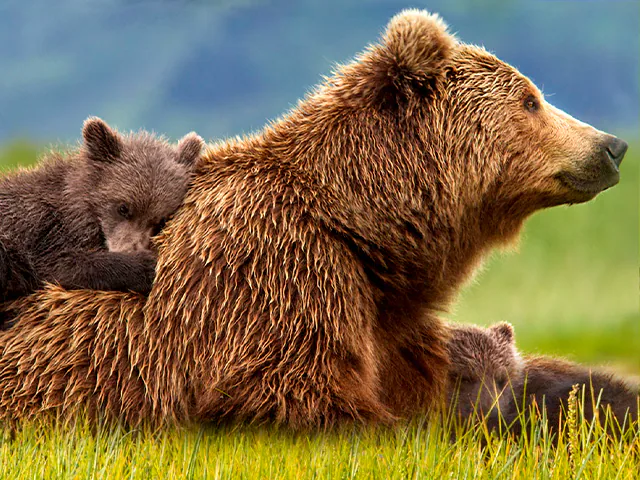
Since the dawn of time and where ever humans and bears have cohabited there have been folklore and spoken myths regarding the Bear from being spiritual creatures to Gods to being a spirit animal for the fierce warrior from the Amerindians to the Northern regions of Europe and all around the world really. I find Bears to be a joy to watch in the wild and just see how they live from the mother Bear raising her cubs to watching them catch salmon in a river. There is so much rich history and stories of Bears in so many different cultures that I decided to offer in this post the best I have found for you to learn more from and hopefully enjoy.
Bear folklore is widespread, especially in the far northern hemisphere. It is not surprising that this awesome beast was one of the first animals to be revered by our ancestors. From as far back as the Palaeolithic (around 50,000 years ago) there is evidence of a bear cult in which the bear was seen as lord of the animals, a god, and even the ancestor of humans. Various species of bear played a central role in many shamanic practices of the north, and brown bears were part of our native forests as recently as the 10th century, when hunting and habitat loss drove them to extinction.
The Celts venerated the bear goddess, Artio – like a mother bear she was a fiercely protective influence. The bear god Artaois is closely linked to the warrior-king, Arthur; with his legendary strength and fighting prowess, Arthur’s name and emblem both represent this animal. Celtic families would often have their own animal totem, a tradition that is still evident in the family name McMahon, which means ‘son(s) of the bear’.
Viking warriors were famous for working themselves into an insane battle frenzy (it has been suggested that the psychotropic fly agaric mushroom was sometimes used). They invoked the bear spirit, at times even donning a bear skin, to imbue them with superhuman strength and fury. These were the Berserkers, their name being derived from a Norse word meaning ‘bear shirt’.
In Greek legend, Zeus fell in love with the huntress Callisto, and she bore him a son named Arcas. In a fit of jealous rage, Zeus’s wife turned Callisto into a bear. Time passed, and one day Arcas was out hunting. How was he to know that the bear he was stalking was his own mother?! On seeing that Callisto’s life was in danger, Zeus whisked her up into the night sky out of harm’s way. She can still be seen in the constellation Ursa Major, the Great Bear. (In another version, Arcas is also sent skywards, and becomes the adjacent Ursa Minor, the Little Bear.) The Big Dipper, or Plough, is one of the more familiar groups of stars within this constellation. Interestingly, the Druidic name for this group was Arthur’s Plough, and the constellation was also seen as a bear in Native American and Hebrew tradition.
In Native American folklore there are many tales about bears. It is highly respected as the ‘keeper of dreams’, and ‘the keeper of medicine’, and is one of the most powerful totems. (Bears hibernate, giving them associations with the world of dreams.)
Human fascination with this animal has not always worked in the bear’s favor. The bear appears in the names of many English pubs, and this is thought to be a hangover from the days bear-baiting – medieval ‘entertainment’ which involved tying a bear to a post and setting dogs on it. The Caledonian bear was said to be so fierce that it was favored by the Romans who used them in their amphitheaters, for similar purposes. In 1902, U.S. President Theodore (‘Teddy’) Roosevelt was on a hunting trip along the Mississippi, but showed mercy to an old bear he could have easily taken as a trophy. The story of this act spread quickly, and the Teddy Bear was born.
Bears still make an appearance in recent literature. Beorn in Tolkien’s The Hobbit was a man who could take the shape of a bear, echoing ancient shamanic practices. And who could forget wise old Baloo, the teacher of the wolf cubs from Kipling’sJungle Book, Paddington Bear (think marmalade sandwiches and hard stares), or Winnie the Pooh? More recently, Benjamin Hoff’s Tao of Pooh used this unassuming bear to illustrate the Taoist principles of modesty, simplicity, and intuitive, practical wisdom. In Phillip Pullman’s Northern Lights, the young heroine, Lyra, befriends a fierce and loyal polar bear king named Iorek Byrnison, helping him to regain his throne. Read more here.
Bear Folklore, Through Myths, Legends and Folktales
Native American Bear Mythology
Following the Bear in Mythology
